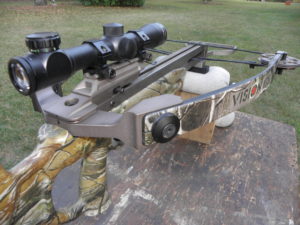Understanding the Flight of the Arrow
By Glen Wunderlich
Archery deer season is upon us Michiganders. While myriad preparations abound with stands and gear, it’s also a good time to understand the flight of arrows, or bolts (for those with crossbows). With that mentioned, the focus will be on certain principles that can be applied effectively to vertical bows or crossbows and the term arrow will be used for simplification.
Computer aids such as ballistic calculators and trajectory charts are a good place to begin. However, there is only one certain way to learn the characteristics of your bow and that’s to shoot it – even if it performed flawlessly in the past. Slight changes in string wear and other mechanical aspects of a bow are in a state of constant change, albeit minimal at times. Add to that any significant changes in arrows, broadheads, dampeners, etc. and your arrows may very well strike targets differently. It’s your duty to find out through testing.
Knowing your range is critical. Rangefinders have become quite affordable over the years and can spell the difference between success and failure. They can be used to set up targets, as well as to identify and range markers such as stumps, rocks or even a decoy at your hunting site. Then, as a deer enters the area, its distance from you will be known without fumbling for anything.
Multi-reticle crossbow scopes must be tested. There simply is no way to trust that the distance indicators on a given scope will correspond to your arrow’s trajectory without doing some shooting. Start at a relatively close range of 20 yards and get the shots close to center. Then, walk the target out to your farthest range you will shoot ethically – say 40 yards. Dial in the arrow at that range and then check it at 30 and 20 yards without changing the scope’s settings. Chances are that the arrows will strike in a conservative 6-inch kill zone. If not, take note.
Personally, my Horton
crossbow launches arrows at a speed of 293 feet-per-second (fps) and then, of course, slows down progressively. Considering the speed of sound at 1120 fps, a deer will hear the sound of the string before the arrow reaches it. The longer the shot, the more time the deer will have to react to the sound.
It’s understood that not all deer will react to the sound of the string snapping, but some will; the term is “jumping the string.” For this reason, I have set a maximum range of 30 yards to minimize the chance of a deer being startled and thus moving. Even though my bow is relatively “quiet” it makes enough noise to surprise a deer in still air at prime time. No manner of practice will help.
If you will hunt from a blind or treestand, take a friend along for a practice session to retrieve arrows for you. It won’t prepare you for an adrenaline rush, but your confidence level will improve, because you’ll understand the flight of your arrow.
Finally, practice by keeping all shots within a 6-inch circle. This conservative target provides some margin for error, but it is still the hunter’s responsibility to know and shoot within his personal limitations.







